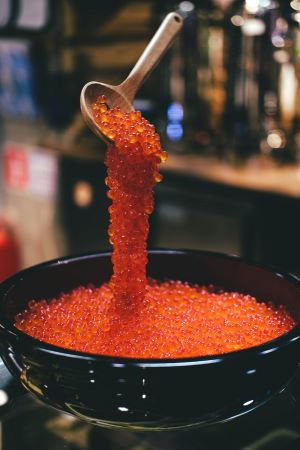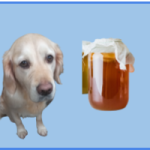
The last couple of years have been tough for most of us.
Whether we have been unfortunate enough to have lost a job or even worse a loved one in this pandemic, life since the first part of 2020 doesn’t offer too many fond memories.
However, there have been a few noticeable exceptions for those people who can afford luxuries.
More Rolls Royces than ever before are being bought and sales of caviar are booming.
And if you are wealthy enough to buy caviar, perhaps you are indulgent enough to feed it to your dog?
But, is it a safe food for dogs to eat?
Can dogs have caviar?
Wow, what a question!
If you are lucky enough to not only afford caviar for yourself but to also consider buying it for your dog to taste, then you have done better in the lottery than I have!
There is nothing toxic or poisonous in caviar that your dog needs to worry about.
Most forms of caviar have huge amounts of added salt but in the small amounts that your dog will be eating this shouldn’t be too much of an issue.
But considering how eye wateringly expensive it is, I look at other types of fish eggs as well as talking about the other types of fish (and by that I mean cheaper) that you might want to consider for your dog.
What is caviar?
Caviar are the processed eggs (roe) of wild sturgeon.
And traditionally speaking, these eggs must only be taken from sturgeon that live in the Caspian or Black Sea.
If the eggs are taken from sturgeon from anywhere else, they aren’t caviar.
And, of course, eggs from any other type of fish aren’t caviar either!
How is caviar made?
That is a bit of a clumsy title because caviar isn’t made, it is processed.
The ovaries are taken from a female sturgeon.
The ovaries are rinsed in order to free the eggs (or roe.)
The eggs are then rinsed with water.
Salt is then added as a way to help preserve the eggs and to create a specific “taste” or “flavour”.
What nutrition does caviar have in it?
A quick look online shows that authentic caviar might be as bad for your dog as it is for your wallet.
In the UK, one of the most expensive caviars (Beluga caviar) costs £62 ($90) for 20g.
If you don’t have any idea how much 20g is, then a small chicken’s egg weighs about 40g.
So it is half of one of those- which isn’t very much at all.
Nutrition wise, caviar tends to be high in fat, sodium, cholesterol and protein.
Now let me start by looking at the cholesterol because this to me seems to be massive- way above any other high cholesterol food that I can find.
100g of caviar contains 633mg cholesterol.
A similar amount of cheddar cheese has 113 mg and heavy cream also has 113 mg.
Don’t worry about what 113 mg means, it is just that caviar contains five times as much!
Next up, it is time to put sodium or salt under the spotlight.
Now, the amount of sodium in caviar can vary between different types so it is important to recognise that.
But this type of caviar contains 1667 mg of salt in every 100g.
Looking at other products that are notoriously high in salt, 100g of pizza contains 740 mg of salt and a bag of “classic” flavoured chips contains about 680 mg.
Pretty unbelievable, right?
And the news doesn’t get any better as we move onto fat.
Caviar contains 20% fat which is very, very high.
It is recommended that an adult dog should only have 5% fat in their diet.
A bit of good news is that the protein content in caviar (around 20%) is closer to the recommended 18% that an adult dog should get.
Another area in which caviar is lacking is in the vitamins and minerals that it contains.
It doesn’t contain any vitamins at all or not any that have been officially measured and mineral wise it only offers one (apart from sodium) in any significant amounts.
And that is iron.
Iron is very important in creating and maintaining red blood vessels.
But if iron is what you want…
Think of all that kale or spring greens you could buy with the £60 that the caviar will set you back.
So having dived into the nutritional benefits of caviar, I want to quickly look at some alternatives in terms of what nutrition they contain and how much they cost.
Can dogs eat caviar alternatives?
All pregnant female fish contain eggs or roe and so how do eggs from other types of fish compare?
I want to look at two popular alternatives: herring and red salmon.
If you are desperate to add fish eggs to your dog’s diet, no matter what the breed of fish the product will also cost a relative fortune.
Partly this is because any product with the name caviar in the title is a license to print money.
Everyone has heard of caviar and knows that it is expensive.
And the second reason that fish eggs will always be hard on your wallet is that extracting the eggs from the fish and processing them takes a lot of time.
But before I list some specific prices, let’s take a look at some nutrition values.
And to help us, I have created a chart.
| 100 g serving | Caviar | Herring | Salmon |
| Fat | 20 g | 6.4 g | 14 g |
| Cholesterol | 633 mg | 374 mg | – |
| Sodium | 1667 mg | 91 mg | 1500 mg |
| Protein | 20 g | 22 g | 29g |
| Vitamins | B2, B12, D | B12, D | |
| Minerals | Iron | Phosphorous, Selenium | Selenium, Magnesium and Iron |
So let me start by looking at the biggest differences.
Herring roe has half the cholesterol of caviar.
Unfortunately despite looking almost everywhere I couldn’t find any information about the cholesterol levels in salmon roe.
We have already mentioned that the sodium levels in caviar are astronomical (1667 mg) and the levels in salmon roe are almost as dramatic (1500 mg) but interestingly the sodium that is present in herring roe, by comparison is tiny.
A mere 90 mg. A figure so low that it doesn’t set off any health alarms.
In terms of fat, caviar leads the rest of the field for all the wrong reasons once more.
It contains 20% fat.
Salmon roe comes in at a more reasonable 14% fat content whereas herring roe once again is the healthiest option, with a fat content of 6.4%.
Next up is protein, which has a more interesting mix.
Highest is salmon with a huge 29%, distantly followed by herring which is 22% protein.
Following closely on its heels in caviar, which for once is at the back of the field.
Earlier, I showed you that caviar contains no known vitamins.
Well, in contrast to that, herring and salmon roe both contain significant amounts of vitamin B12 and Vitamin D.
In addition, herring roe contains lots of vitamin B2.
But why are these vitamins important?
B vitamins help to strengthen the immune system and to make a dog’s metabolism as effective as possible.
Vitamin D is the sunshine vitamin.
It is produced in humans and dogs from exposure to the sun.
But dogs also absorb it from eating certain types of meat such as liver, fish and eggs.
Which is a weird list when I’m talking about a variety of fish eggs which are high in vitamin D….
Let us now move onto minerals.
We have already highlighted the presence of iron in caviar and its role in a dog’s body.
Salmon also contains lots of iron.
Herring roe and salmon roe both contain a mineral called selenium.
Selenium helps a dog’s thyroid to function properly and it is also involved in boosting a dog’s immune system.
Herring roe contains relatively high amounts of phosphorus.
And phosphorus helps to build strong healthy bones.
Finally, salmon roe contains lots of magnesium.
And magnesium is thought to support hundreds of tiny functions in a dog’s body.
And one of these is that it helps to keep the heart beating steadily.
I think we should wrap up the biology lesson at this point, don’t you?
So far, I have looked at whether dogs can eat caviar and fish eggs.
Realistically, these products are financially out of reach for most of us and I want to finish off this article by talking about what other fish parts might be a more appropriate addition to your dog’s diet.
Can dogs eat fishbones?
Most of us tend to buy fillets of fish.
With a bit of seasoning and a drizzle of oil after a few minutes of preparation they are all ready to go.
However, some of us like to do things differently and I occasionally fall into this trap.
If you have ever bought fish directly from a fish counter or a fishmonger, you know that there is quite a bit of preparation to do and parts of the fish that need to be thrown away.
Which is where dogs can come in handy.
Throwing parts of fish away throws my head into a spin for two reasons.
Firstly either raw or cooked fish will stink your trash out and secondly I hate waste and so I like to give my dogs what I can.
But most of these waste parts aren’t very dog friendly.
Fish heads can be choking hazards to our dogs and unless I’m careful my dogs will get the fins stuck in their throats and then spend their time retching!
The same goes for fish bones.
Although they are packed full of flavour and nutrients, the possibility of your dog choking on these is very, very high.
I have written an article about fish bones and in it I explain that the best way to feed fish heads and fish bones to your dog is as a fish broth!






